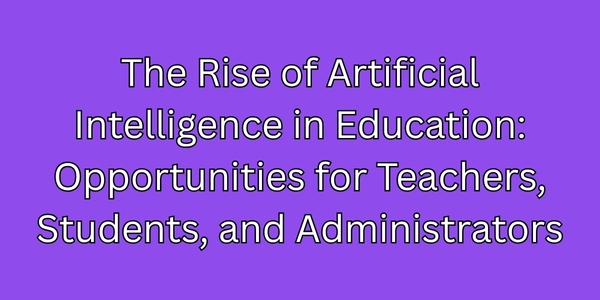Artificial Intelligence (AI) is no longer a futuristic concept—it’s transforming classrooms, enhancing instruction, and streamlining educational operations today. But as with any innovation, understanding what AI is—and what it isn’t—is crucial. In this blog post, we’ll explore the different types of AI, how they apply to education, and the significant benefits they offer to teachers, students, and administrators alike.
What is Artificial Intelligence?
At its core, Artificial Intelligence refers to machines or software that mimic human cognitive functions like learning, problem-solving, and decision-making. But AI is not a single technology—it’s a spectrum. Here’s a quick breakdown:
- Narrow AI (Weak AI): This is the most common form of AI today. It is designed to perform a specific task—like recommending content, grading assignments, or answering questions in a chatbot. Examples include ChatGPT, Grammarly, and AI tutors like Khanmigo.
- General AI (Strong AI): This type of AI (still theoretical) would be capable of understanding and learning any intellectual task a human can do. It doesn’t exist yet, but it fuels much of the imagination (and concern) around AI.
- Machine Learning (ML): A subset of AI that involves training machines to learn from data and improve over time without explicit programming. It’s what powers adaptive learning platforms and predictive analytics tools.
- Generative AI: A form of AI (often based on large language models) that can create new content—text, images, videos, or code—based on prompts. This is the kind of AI behind tools like ChatGPT and image generators like DALL·E.
Understanding these distinctions helps us better grasp how AI is reshaping education.
Benefits for Teachers
Teachers are the cornerstone of education, and AI tools can help lighten their workload while improving instructional effectiveness.
Personalized Learning Plans
AI-powered platforms can analyze student performance data and suggest customized lessons or remediation plans. This helps teachers meet each student where they are.
Automated Grading and Feedback
AI can assist with grading multiple-choice tests, essays, and even providing real-time feedback on student writing, freeing up hours of time for deeper instructional tasks.
Curriculum Support
Generative AI tools can help teachers generate quiz questions, lesson plans, reading passages, and discussion prompts in seconds—especially useful when planning under time constraints.
Professional Development
AI-driven platforms can suggest training resources tailored to a teacher’s subject area, strengths, or classroom challenges.
Benefits for Students
AI has the potential to empower students with more personalized, engaging, and supportive learning environments.
Adaptive Learning
AI-powered platforms like DreamBox or Carnegie Learning adjust the difficulty of tasks in real-time based on a student’s responses, helping ensure they remain challenged but not frustrated.
24/7 Tutoring Support
Chatbots and AI tutors can offer homework help and explanations outside of school hours, making learning more accessible.
Feedback and Writing Support
Tools like Grammarly and AI writing assistants help students improve their writing by offering grammar corrections, clarity suggestions, and stylistic feedback.
Enhanced Accessibility
AI can provide text-to-speech, speech-to-text, real-time translations, and more—helping students with disabilities or language barriers access content more equitably.
Benefits for Administrators
AI is not just for instruction—it can optimize school and district operations as well.
Data-Driven Decision Making
AI can analyze data trends related to attendance, academic performance, behavior, and more—helping leaders identify at-risk students, allocate resources, and design interventions more effectively.
Streamlined Operations
From predictive enrollment forecasting to AI-assisted scheduling, automation can save time and reduce administrative overhead.
Improved Communications
AI chatbots and automated messaging tools can handle parent inquiries, distribute alerts, and share updates in multiple languages, improving engagement and efficiency.
Ethical Considerations and Cautions
While the benefits are exciting, there are concerns educators and institutions must address:
- Bias in AI algorithms
- Data privacy and student safety
- Over-reliance on automation
- Equitable access to AI tools
It’s essential to approach AI adoption thoughtfully, ensuring transparency, fairness, and ongoing human oversight.
Final Thoughts
AI is not here to replace educators—it’s here to support them, empower students, and streamline operations. When used responsibly, artificial intelligence can be a powerful partner in the classroom and beyond.
As we continue exploring this rapidly evolving field, educators must be proactive in learning about AI, testing its tools, and advocating for policies that ensure its ethical and equitable use.
